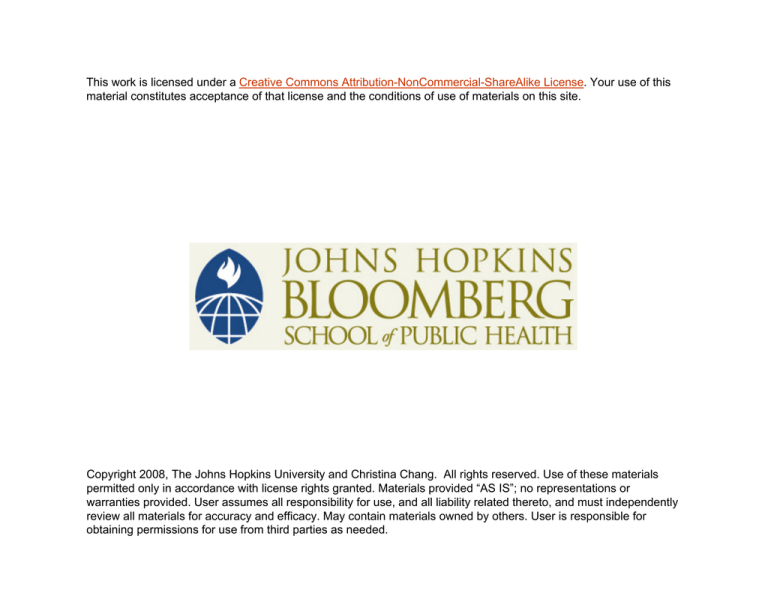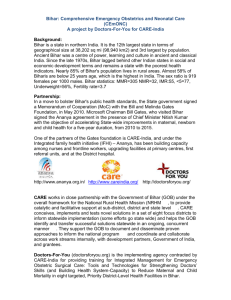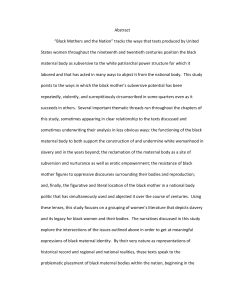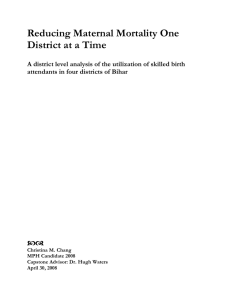
This work is licensed under a Creative Commons Attribution-NonCommercial-ShareAlike License. Your use of this
material constitutes acceptance of that license and the conditions of use of materials on this site.
Copyright 2008, The Johns Hopkins University and Christina Chang. All rights reserved. Use of these materials
permitted only in accordance with license rights granted. Materials provided “AS IS”; no representations or
warranties provided. User assumes all responsibility for use, and all liability related thereto, and must independently
review all materials for accuracy and efficacy. May contain materials owned by others. User is responsible for
obtaining permissions for use from third parties as needed.
Reducing Maternal Mortality
One District at a Time
A district level analysis of the
utilization of skilled birth attendants
in four districts of Bihar
By Christina Chang
Objective
• Explore patterns, determinants, and
disparties between the poor and the
better-off in the proportion of deliveries
attended by a skilled birth attendant in
four districts of Bihar - West
Champaran, Jehanabad, Samastipur,
and Katihar
Background
• Bihar
• Highest percentage of people living in poverty in
any single state in India
• Large rural population - urbanization is low in
Bihar (10.5%)
• Government criticized for
• Lack of transparency
• Unresponsiveness to citizen needs
• High levels of corruption
Background
• Bihar has extremely
low rates and large
socioeconomic
differences in the
use of skilled birth
attendants at
delivery
Proportion of women utilizing skilled birth attendants
at delivery in Bihar, Madhya Pradesh, Andhra
Pradesh, Tamil Nadu, and all of India, (DLHS, 2002)
100.00%
90.28%
80.00%
66.53%
60.00%
42.40%
40.00%
34.71%
26.81%
20.00%
0.00%
Bihar
(CI: 0.31)
Madhya
Andhra Tamil Nadu
All India
Pradesh (CI: 0.28) Pradesh
(CI: 0.33)
(CI: 0.16) (CI: 0.04)
Conceptual Model
Demand Side Barriers
Perceived quality
Unaffordable formal &
informal payments
Delay 1
Deciding to seek care
Supply Side Barriers
Delay 2
Identifying &
reaching an
appropriate
institution
Health info communication
Delay 3
Receiving adequate
& appropriate
treatment
Facility quality &
cleanliness
Facility location & hours
Education
Cultural, community, &
religious norms
Substitute availability &
affordability: traditional
healers & home deliveries
Identifying & reaching an
appropriate institution
Drug and medical supply
quality & availability
Maternal Mortality
Wage, availability, &
quality of health workers
Adapted from Maine & Thaddeus. (1994) Too Far to Walk: Maternal Mortality in Context. Soc. Sci Med. Vol 38 No. 8
Data & Methodology
•
•
•
District Level Household
Survey (DLHS), 2002
• West Champaran: 712
women
• Jehanabad: 561 women
• Samastipur: 629 women
• Katihar: 606 women
Multivariate logistic
regression
Dependent variable
• Skilled birth attendants +
institutional deliveries
•
Explanatory variables
• Wealth quintile
• Education of mother
• Education of husband
• Religion
• Caste/Tribe
• Number of ANC visits
• Age of mother
• Place of residence (rural or
urban)
Inter-district inequalities
• All district have low
rates of utilization of
skilled birth
attendants
• Some districts do
worse than others.
Clearly, there are
inter-district
differences
Proportion of women utilizing skilled birth attendants
at delivery in West Champaran, Jehanabad,
Samastipur, and Katihar, (DLHS, 2002)
100%
90%
80%
70%
60%
42.7%
50%
40%
36.2%
25.9%
30%
15.1%
20%
10%
0%
West
Champaran
Jehanabad
Samastipur
Katihar
Intra-district inequalities
Proportion of women utilizing skilled birth attendants at delivery
in West Champaran, Jehanabad, Samastipur, and Katihar by
wealth quintile (DLHS, 2002)
Poorest 20%
Second
Middle
Fourth
•
Richest 20%
90.0%
80.0%
70.0%
•
60.0%
50.0%
40.0%
30.0%
20.0%
10.0%
0.0%
West
Champaran
(CI: 0.05)
Jehanabad
(CI: 0.23)
Samastipur
(CI: 0.40)
Katihar:
(CI: 0.29)
Inequality is highest in
Samastipur, indicated by
CI: 0.40
• Poorest 20%: 4.8%
• Richest 20%: 54.2%
Inequality is smallest in
West Champaran,
indicated by CI: 0.50
What mattered?
• Wealth status mattered for all districts
except West Champaran.
Wealth Quintile
Q1: Poorest 20%
Q2: Second
Q3: Middle
Q4: Fourth
Q5: Richest 20%
West
Champara
(CI: 0.05)
Ref. Cat.
0.89
0.71
0.73
1.18
Jehanaba
d
(CI: 0.23)
Ref. Cat.
1.11
0.97
1.39
3.13***
Samastipu
r
(CI: 0.40)
Ref. Cat.
1.78
3.30***
3.64***
8.00***
Katihar
(CI: 0.29)
Ref. Cat.
0.34***
0.7
0.62
3.37***
***significant at the α=0.01 level **significant at the α=0.05 level * significant at the α=0.10
What mattered?
• Mother’s education was a statistically
significant predictor for SBA utilization
for the two lowest performing districts,
Samastipur (OR: 4.7) and Katihar (OR:
3.4).
• Having an educated husband was
associated with greater odds of utilizing
SBA at delivery in all districts
What mattered?
• Household religion only mattered in
Jehanabad
• Hindu women had 50% less odds than
Muslim women
• Household caste only mattered in
Jehanabad
• OR comparing women from non-scheduled
castes and tribes to women belonging to
scheduled castes and tribes: 3.2
What mattered?
• Effect of age was not statistically significant after
adjusting for other covariates but generally showed a
reduction in odds of using SBA with increasing age.
• Place of residence under bivariate analysis showed
increased odds of delivery by SBA in urban versus
rural. After adjusting for other covariates, place of
residence only mattered in Samastipur.
• OR 3.7 comparing urban to rural
What mattered
• The number of ANC visits are STRONGLY
associated with increased odds in using skilled care
at delivery in all districts after controlling for
covariates
Number of ANC Visits
No visits
1 visit
2 visits
3 visits
4 visits
West
(CI: 0.05)
Jehanabad
(CI: 0.23)
Samastipur
(CI: 0.40)
Katihar
-0.29
Ref. Cat.
Ref. Cat.
Ref. Cat.
Ref. Cat.
0.72
0.78
1.71
3.36***
1.73
4.77***
6.09***
4.69***
4.99***
3.98***
9.57***
20.58***
2.81***
2.45***
2.71***
2.55**
***significant at the α=0.01 level **significant at the α=0.05 level * significant at the α=0.10
Inter-district inequalities
(The district a women lives in matters)
District
RichPoor OR
Q1
Q2
Q3
Q3
Q5
Total
Samastipur
Katihar
Jehanabad
West Champaran
Ref. Cat.
1.48**
3.02***
3.59***
4.8%
19.1%
25.8%
34.5%
8.6%
8.5%
30.4%
36.2%
15.4%
16.8%
27.3%
30.6%
23.5%
24.7%
42.4%
37.8%
54.2%
76.1%
77.9%
60.0%
15.1%
25.9%
42.7%
36.2%
CI
0.3980
0.2908
0.2255
0.0532
CI Std
Error
0.1162
0.1513
0.0483
0.0677
• Women in West Champaran and Jehanabad are 3
times more likely than women in Samastipur to
deliver with the assistance of a SBA
• The poorest households within the lowest performing
districts are the most unreached and underserved
Policy Implications
Four delivery care models
(Where they now and where should they aim to go?
•
•
•
•
Model 1: Non-professional delivery at home
Model 2: SBA delivery at home
Model 3: SBA delivery basic EOC facility
Model 4: SBA delivery in comprehensive
EOC facility
• Countries successful at reducing MMR
moved from model 1 to model 2,3, or 4.
• Bihar is currently a Model 1 state
Source: Koblinksy et al. and the World Bank
Learning from other countries
• Honduras
• Indonesia
• Sri Lanka
Honduras
• Model 2 may not be enough to achieve reductions in
MMR
• MMR reduction strategies aimed to meet the needs of
the worst-off in the country:
•
•
•
•
Targeted regions with highest maternal mortality ratios
Built 7 new rural area hospitals
Built 5 maternity waiting homes along side rural hospitals
Build 8 birthing centers
• Community participation and ownership of birth centers
• Traditional birth attendants: trained to recognize danger
signs. Found that TBAs were referring women correctly
and often accompanied women to facilities
Indonesia
• Initial strategy: Train traditional birth
attendants - did not work for them
• Village-based midwives
• Surge of deliveries attended by SBA but no
change in institutional deliveries
• Learning from Indonesia’s mistakes:
• Only been able to move from model 1 to model 2
• Did not address demand-side barriers
• Lack of transportation
• High costs of care
• Cultural appropriateness of institutional deliveries
Learning from the data
•
•
Among women who did
not deliver in an
institutional setting, “too
far/no transportation” was
the second most common
reason in every district
More women from poorer
households state distance
and transportation barriers
as their primary reason for
not delivering in an
institution
Percent of women stating “too far/lack of transportation”
as their primary reason for not delivering in an institution
by quintile, (DLHS, 2002)
45.00%
40.00%
35.00%
30.00%
25.00%
20.00%
15.00%
10.00%
5.00%
Q1 Q2 Q3 Q4 Q5
Q1 Q2 Q3 Q4 Q5
Q1 Q2 Q3 Q4 Q5
Q1 Q2 Q3 Q4 Q5
West Champaran
Jehanabad
Samastipur
Katihar
0.00%
Sri Lanka
•
•
Professionalism of midwives
• Midwives made frequent visits to villages to provide
antenatal care to women
Information system
• Civil registration of maternal deaths as a tool to raise
importance of maternal deaths in villages
• Initiated maternal death reviews that included investigations:
• Interviews with local midwives, community leaders,
district hospitals, househoold members
• Two important benefits:
• Provides meaningful information to decision-makers to
make immediate and appropriate programmatic changes
• Raises importance of maternal deaths in a culture that
has accepted maternal death as tragic yet accepted part
of childbearing
Policy Actions
•
•
Increase the number of midwives in villages, supported by a strong
referral network
• Midwives are frontline workers who educate mothers, provide
essential medical care during her pregnancy, and coordinate and
prepare the household with clear instructions on what to do when
the mother goes into labor
Increase the number of birthing facilities embedded in a strong referral
network
• Strategy should be similar to Honduras: build in rural areas with high
MMR
• Birthing centers closer to women in remote rural areas
• Maternal waiting homes can help address geographical barriers
Policy Actions
•
•
Provide free or subsidized transport services from villages to facilities
• Transportation is a major barrier for women in the four districts
• Transportation from villages to nearby birthing centers, between
basic EOC facilities to comprehensive facilities should be reliable
and affordable
Make decisions using a community-based participatory approach
(example: beneficiary assessments)
• Qualitative tools can be used to understand the special needs of a
community
• Decision should include input of village members, leaders, local
NGOs, district officials…
• Projects that originate from a participatory approach are more likely
to be accepted and utilized by the beneficiary population.
Policy Action
• Implement an information system that records
maternal deaths to monitor and evaluate district level
successes
• Perhaps the most difficult to implement
• Village norms such as burial ceremonies could be
used to identify deaths.
• Main idea: raise importance of maternal death at
the village level
Conclusion
• Nature of the problem is very complex and simple
solutions are likely to fail
• Kingdon: policies are only likely to be taken seriously by
government when policy streams run together
• Problem: perception of problems as a matter of
requiring government action
• Solution: an analysis of the problem and its solutions
• Politics: political will or shift in politics (example:
elections)
• The extent to which policy recommendation will be put into
action depends now on the political will of Bihar…










